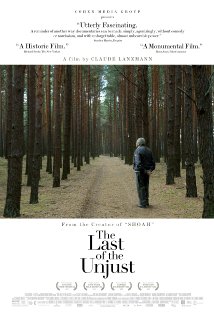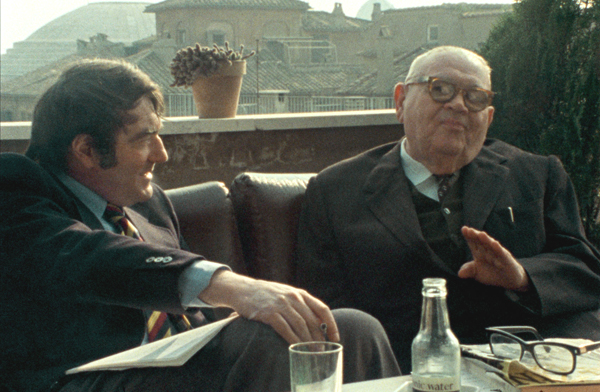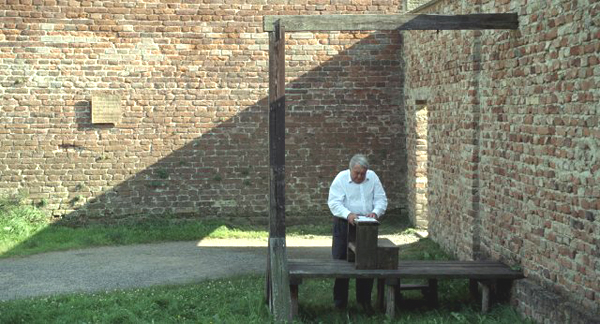

AND
UNIMAGINABLE!
Review by John Delia
Devastating and Unimaginable The Last of the Unjust is a mind boggler. Taking a closer look at the Jewish holocaust from a different perspective, the documentary delves into those that assisted the Nazis during their occupation of conquered countries during WWII. One such collaborator, Benjamin Murmelstein is featured in the film and gives a nearly four hour interview about his participation. The film delivers an interesting perspective to historians who consider Murmelstein a hero and evidence for those who thought he was not.
The documentary involves an interview with Rabbi Dr. Benjamin Murmelstein from Vienna, Austria, where he became a part of the Cultural Council following the occupation of the country by the Nazis in 1938. As in other cities, the Jews were charged by the Nazis with organizing actions in the Jewish community, including selection of people for transport when the Germans decided to deport them, beginning in 1942. He was assigned to Adolph Eichman who he maneuvered to get the necessary help for the Jewish community for which he served. In 1941 he was ordered to go to the dismantled country of Czechoslovakia at Prague by the Nazis to become one of the three Elders at Theresienstadt.


Theresienstadt was a ghetto of 40,000 Jews set up to show the world that the Jews were being treated with compassion in a special community. Here they were shown in propaganda films to be happy, had schooling and enjoyed sports activities provided by the Nazis for their entertainment and well being. Included in the Murmelstein’s reasons why this ghetto was given special treatment was to keep Eichmann in money from the funding of the city by the German treasury. However, under the false shroud were the murderous hangings and other atrocities of those who defied the German government. Eventually 50,000 people were crowded into a space originally set up as barracks for 7,000 German Soldiers.
At Theresienstadt, Murmelstein was appointed third Elder on the Jewish Council and was put in charge of city maintenance and health. He served the position before becoming President of Elders when his two predecessors were eliminated by the Nazis. He was the only Elder who survived in Theresienstadt when it was finally turned over to the International Red Cross in 1945. No villagers were left; all had been transported to the death camps at Treblinka and Auschwitz for extermination.


The war makes strange bedfellows and according to Murmelstein he was smart enough to get close to Eichmann to gain his trust. It allowed him to work his way into situations to help his fellow Jews and according to his statements was able to assist 120,000 flee from the Nazis between 1939 until 1945.
The film includes the full interview by Director Claude Lanzmann who recorded it on film in 1975 in Rome, Italy where Murmelstein retired. He had been acquitted by the Chez Government from wrong doing some time after the International War Crimes Tribunal in Nuremberg, Germany in the 1970’s. While Lansmann asks some very pointed questions, he also showed empathy for the man who lived his life on the edge.
You will have to watch the film and make your own decision on whether you think Benjamin Murmelstein was telling a tale or was truthful in every way about his participation in the ghetto and his collaboration with Eichmann. Was he just a survivor of a horrific crime on humanity or a sharp selfless man who wanted to live no matter what it took or who he hurt?
During the film Lanzmann shows a synagogue where at the altar the following Jewish holocaust locations are inscribed: Terezin or Theresienstadt (a ghetto concentration camp in the Czech Republic), Majdanek (a concentration camp in Poland), Lubin (a concentration camp in Poland),   Christianstadt (a concentration camp in Niederschlesien, Germany), Warszawa or Warsaw (a ghetto concentration and labor camp in Poland), Nisko (a concentration camp in Poland), Izbica (a ghetto concentration camp in Poland), Riga (a concentration camp in Latvia), Oswecim or Auschwitz (an extermination camp in Poland), Treblinca (an extermination camp in Poland), Zamosc (a ghetto and the site of the murder of hundreds of Jews in Poland), Kaufering (subsidiary concentration camps of the Dachau camp), Maly Trostinec or Trostinet (an extermination camp in Germany), Chelmno (an extermination camp in Poland), Lodz (a concentration camp for children in Poland), Schwarzheidi (a concentration camp in Germany), Mauthausen (a concentration camp in Austria) and Sztutowo or Stutthof (a concentration camp in Poland). These are only 20 of the 70 concentration camps, ghettos, extermination camps, transit camps, collective points and labor camps listed in Wikipedia.
FINAL ANALYSIS: A must see film about human suffering that boggles the mind. (A)
Additional Film Information:
Interviewer: Claude Lanzmann
Subject: Benjamin Murmelstein
Directed and Written by: Claude Lanzmann
Genre: Documentary, Holocaust
MPAA Rating: PG-13 for some thematic material
Running Time: 3 hrs 40 min Â
Opening Date: February 7, 2014
Distributed by: Cohen Media
